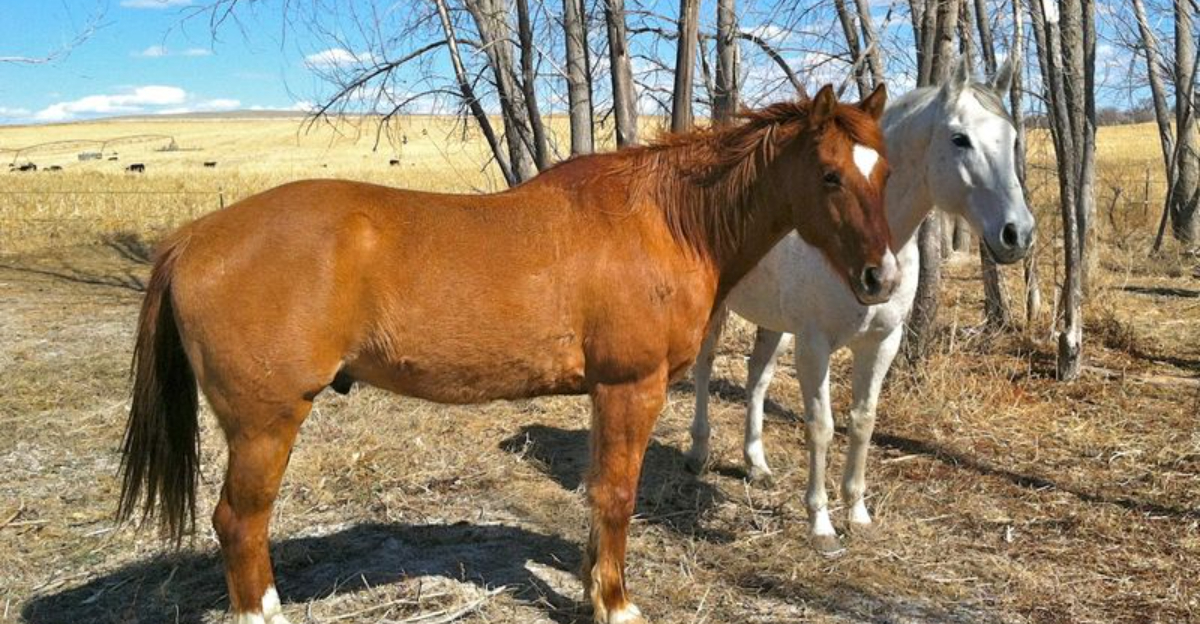Imagine catching a glimpse of a mountain lion outside your window—then realizing it’s no dream. California isn’t just bear and coyote territory, it’s becoming prime cougar country too.
From Hollywood Hills to Silicon Valley, these apex predators are adapting to city life, and sightings are rising.
It’s a wild new reality: humans and mountain lions sharing driveways, hiking trails, even backyards.
Let’s explore the top five places where California’s big cats are becoming unexpected neighbors—and what that means for both wildlife and you.
1. Majestic Arabian
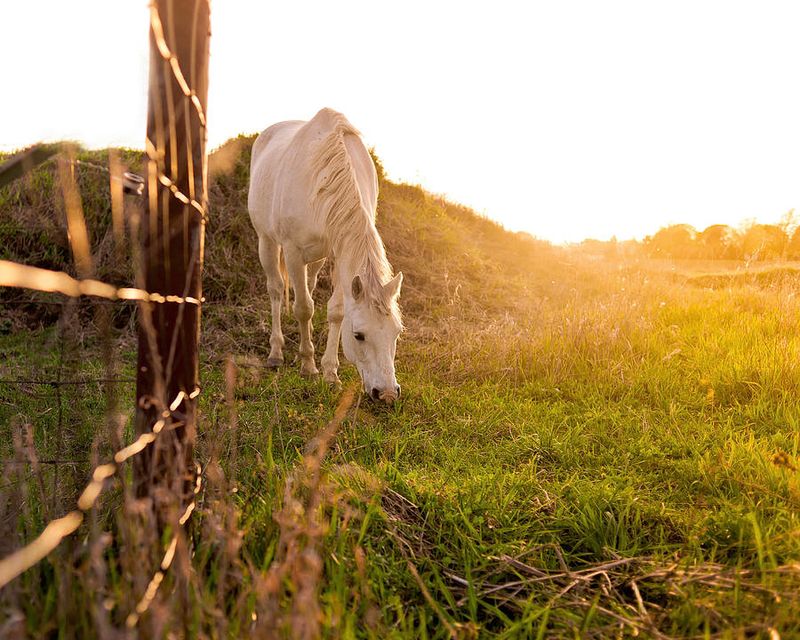
Nothing makes my heart race like watching an Arabian horse in full gallop across a California sunset. With their distinctive dished faces and high-carried tails, these ancient beauties practically float across the landscape.
Last summer, I watched a chestnut Arabian mare named Sahara perform at a ranch near Paso Robles. Her flared nostrils and arched neck embodied 5,000 years of selective breeding perfection.
Arabians thrive in our California climate, reminiscent of their desert origins. Their intelligence makes them incredible partners for everything from pleasure riding to competitive dressage, while their legendary endurance keeps them at the top of distance riding events throughout the state.
2. Versatile American Quarter Horse
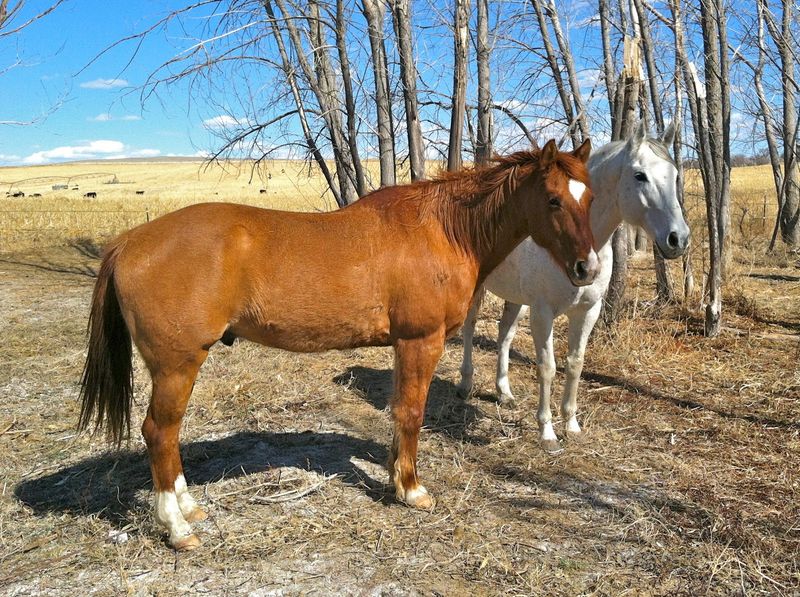
You’ll find American Quarter Horses on practically every California ranch, and for good reason! These muscular powerhouses earned their name by dominating quarter-mile races, but their versatility makes them California’s go-to ranch companions.
My first riding lesson was on a gentle Quarter Horse named Buck at a ranch near Petaluma. Despite their impressive speed and strength, these horses possess a level-headed temperament that makes them perfect for beginners and experts alike.
Their compact, powerful hindquarters make them unbeatable for quick maneuvers when working cattle. California ranchers particularly value their innate “cow sense” – an almost supernatural ability to anticipate a cow’s movements, making cattle work look like an elegant dance.
3. Spotted Appaloosa
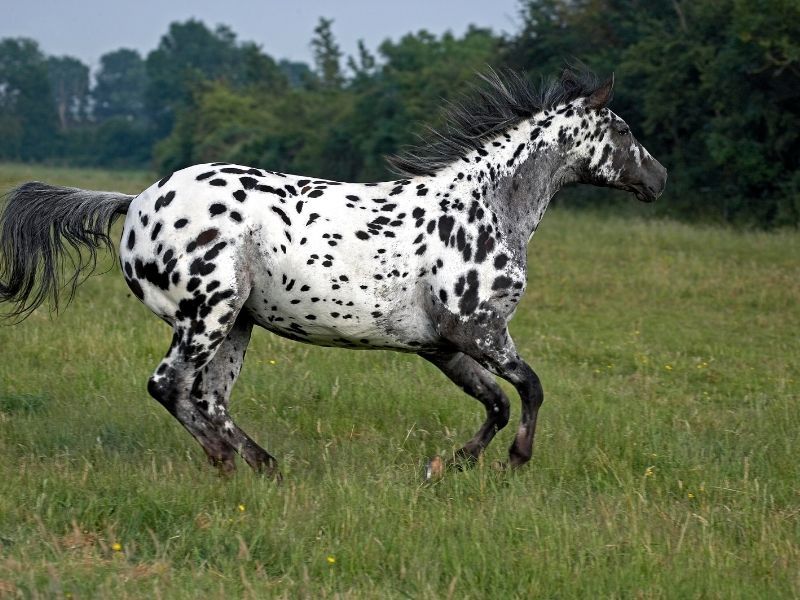
Appaloosas turn heads wherever they go with their spectacular spotted coats that seem designed by a playful artist. Each one sports a unique pattern – from leopard spots to blanket markings – making them living masterpieces grazing across California’s landscape.
During a trail ride near Julian, I rode alongside a striking Appaloosa whose coat pattern reminded me of a starry night sky. Beyond their eye-catching appearance, these horses bring a rich cultural heritage as the prized mounts of the Nez Perce tribe.
California ranchers appreciate their sure-footedness on our varied terrain. Their striped hooves (often harder than other breeds) and distinctive mottled skin around the eyes and muzzle are telltale signs you’re looking at this remarkable breed with Native American roots.
4. Steadfast Morgan
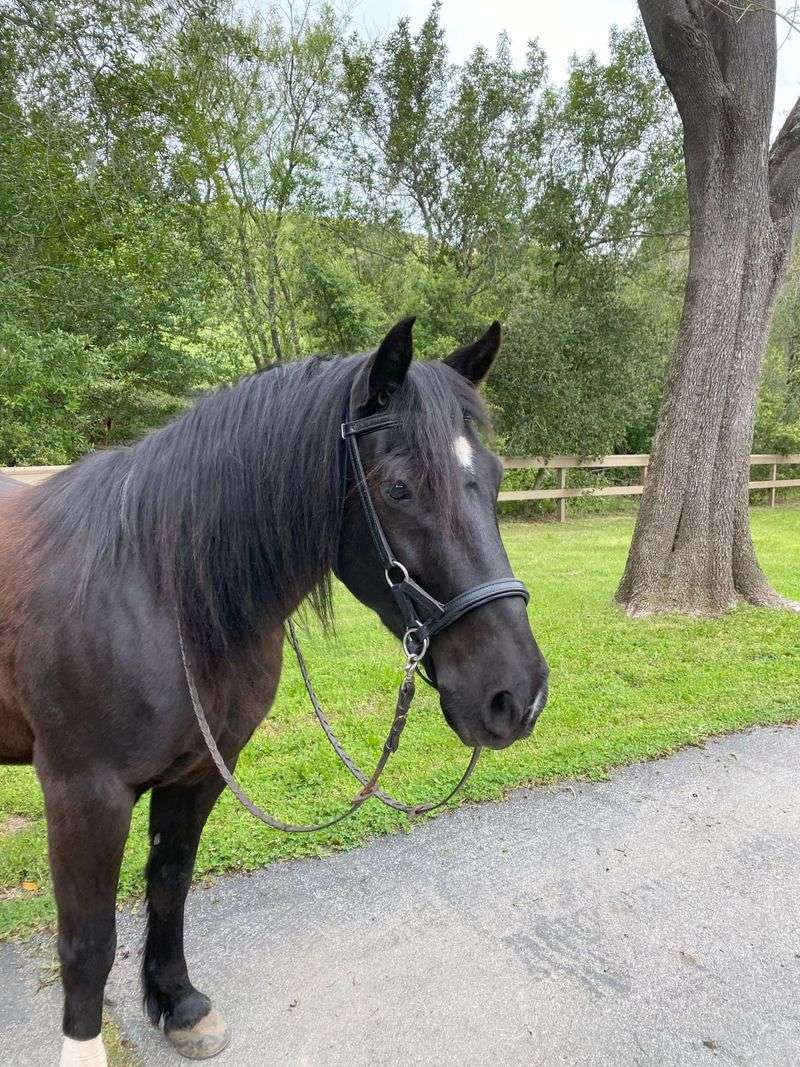
Morgans bring old-world class to California ranches with their proud carriage and flowing manes. These horses trace back to a single foundation sire – a bay stallion named Figure, later renamed Justin Morgan after his owner.
At a historic ranch near Sonoma, I watched a compact Morgan gelding outwork horses twice his size. What these horses lack in height, they make up for with heart! Their willingness to tackle any job makes them beloved partners for California ranchers.
The breed’s trademark traits include expressive eyes that seem to look right into your soul. California’s Morgan enthusiasts particularly treasure these horses for their versatility – equally at home pulling a carriage through wine country or competing in Western pleasure classes at our state fairs.
5. Elegant American Saddlebred
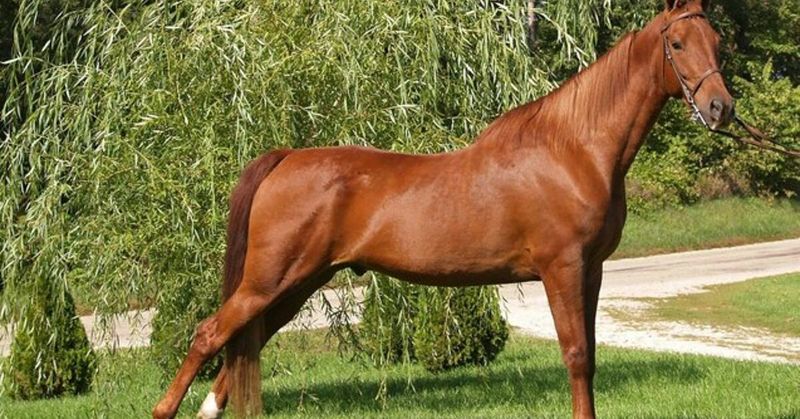
American Saddlebreds strut across California show rings like supermodels on a runway. Nicknamed “peacocks of the horse world,” these high-stepping beauties carry themselves with an almost impossible elegance.
My jaw dropped watching a five-gaited Saddlebred perform at a Santa Barbara exhibition. These athletes perform unique gaits beyond the standard walk, trot, and canter – adding the smooth rack and the thrilling slow gait that seems to suspend them in mid-air.
Their graceful necks and expressive ears give them an aristocratic presence that draws admirers at every California horse show. While less common on working ranches, these horses excel in driving competitions and saddle seat events throughout the state, bringing a touch of Southern elegance to California’s equestrian scene.
6. Powerful Friesian

Friesians look like they’ve galloped straight out of a fairy tale and onto California’s ranches. Their jet-black coats gleam in the sunshine while feathered legs create a dramatic silhouette against our golden hills.
I’ll never forget meeting a Friesian stallion named Midnight at a breeding farm near Santa Ynez. Despite his imposing size, he moved with ballet-dancer grace, his muscular frame carrying him with surprising lightness.
Originally bred as war horses, these gentle giants now capture hearts with their willing temperaments and striking appearance. California’s film industry frequently features these photogenic beauties in movies and commercials, while dressage riders prize their natural collection and impressive knee action that seems to defy gravity with every stride.
7. Wild-Spirited Mustang
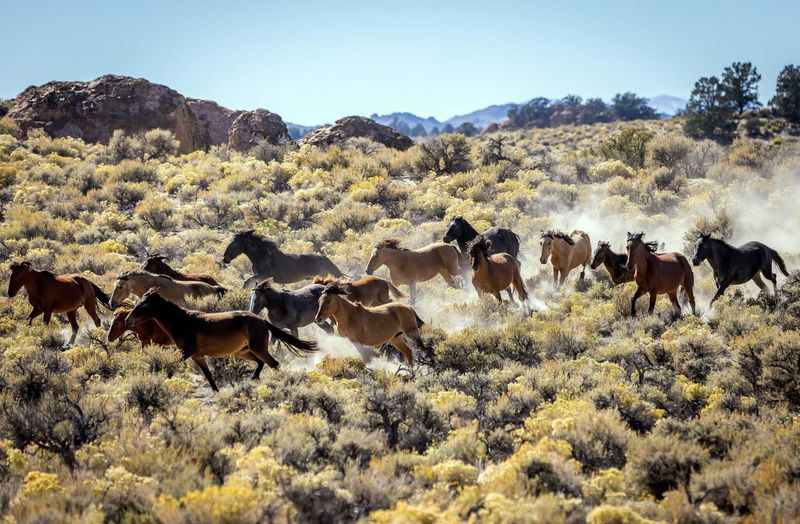
California’s Mustangs carry the spirit of the American West in every thundering hoofbeat. These living legends descend from Spanish horses brought to the Americas centuries ago, then shaped by natural selection into the ultimate survivors.
On a conservation ranch in Modoc County, I watched a herd of Mustangs move as one across the landscape. Their freedom of movement and alert expressions spoke of generations living wild on the range.
Many California ranches participate in Mustang adoption programs, giving these heritage horses new purpose. Though smaller than many domestic breeds, Mustangs bring unmatched hardiness and surefootedness to trail riding adventures. Their natural intelligence and problem-solving abilities often surprise owners who take on the rewarding challenge of earning a Mustang’s trust.
8. Smooth-Gaited Paso Fino
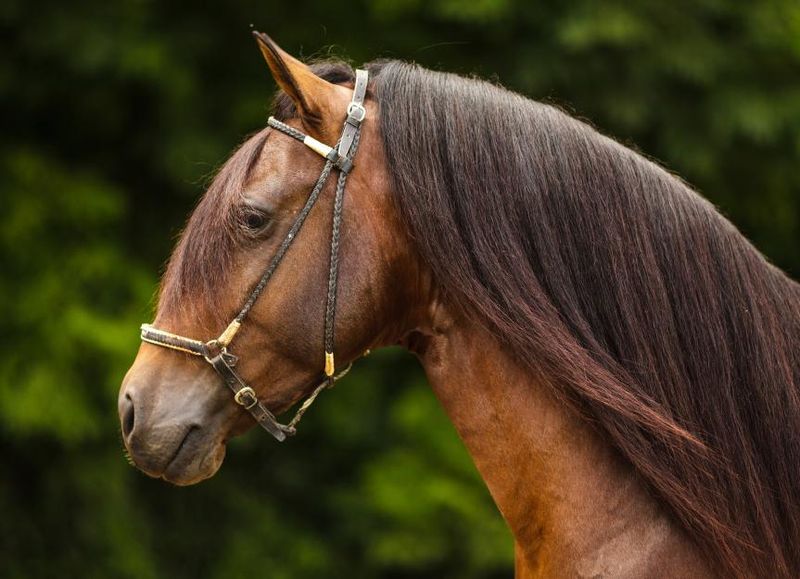
Paso Finos bring Latin flair to California’s equestrian scene with their unique four-beat gait that feels like floating on air. When I first rode a Paso Fino mare on a vineyard trail in Temecula, I was astonished – no posting required, just smooth sailing across the terrain.
Their name means “fine step” in Spanish, perfectly describing their distinctive movement. These medium-sized horses carry their riders with minimal bounce, making them popular choices for Californians with back problems or those seeking comfortable long-distance rides.
California’s Spanish heritage makes these horses right at home here. Their willing attitudes and people-oriented personalities make them wonderful family horses, while their natural collection and elegant carriage turn heads at specialty shows throughout the state where they showcase their signature smooth-as-silk gaits.
9. Cadenced Peruvian Paso
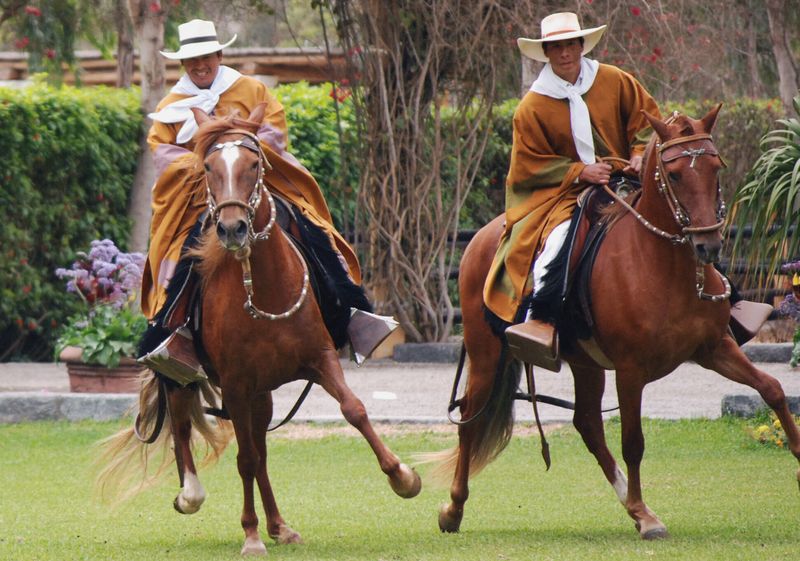
Peruvian Pasos dance across California ranches with a natural rhythm that seems set to music. Their unique lateral gait called the “paso llano” creates such minimal motion in the saddle that riders traditionally balance a glass of champagne while riding!
During a heritage horse festival in San Juan Capistrano, I watched in awe as a chestnut Peruvian Paso performed with traditional silver-decorated tack. The horse’s legs seemed to float sideways in a mesmerizing motion called “termino” – a graceful, outward swinging action of the front legs found in no other breed.
California’s climate mirrors their Peruvian homeland, making them ideal partners here. These horses come with centuries of selective breeding focused exclusively on smooth gaits and willing temperament, never for speed or jumping ability, creating truly specialized riding partners.
10. Fairytale Gypsy Vanner
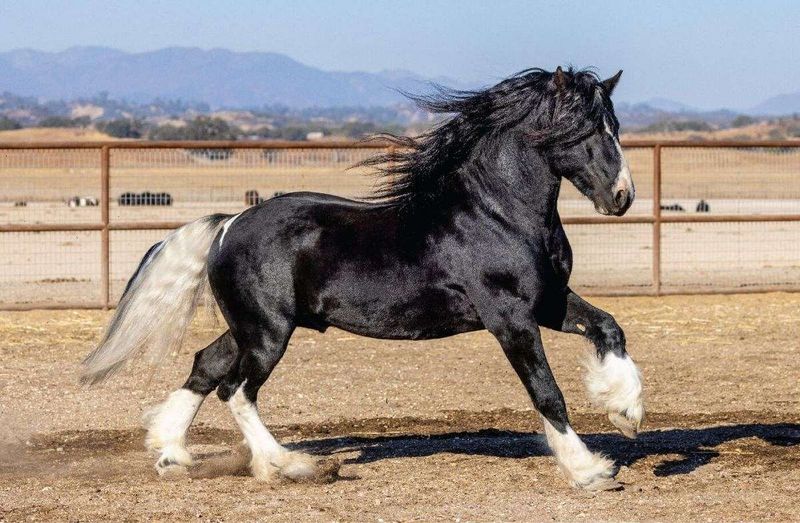
Gypsy Vanners look like they’ve stepped straight from a storybook onto California’s picturesque ranches. Their abundant feathering – the long hair covering their legs – sways like dancers’ skirts with each step they take.
My camera couldn’t capture enough angles when I met a piebald Gypsy Vanner stallion at a specialty farm in Gilroy. His flowing mane and tail, combined with dramatic black and white markings, created a living work of art grazing in the California sunshine.
Relatively new to American shores, these horses were traditionally bred by Romani travelers to pull their vardos (wagon homes) through the British countryside. California breeders now raise these gentle giants for their striking appearance and kind temperaments. Their surprising strength and willing attitudes make them versatile partners for everything from driving to trail riding.
11. Smooth-Riding Missouri Fox Trotter
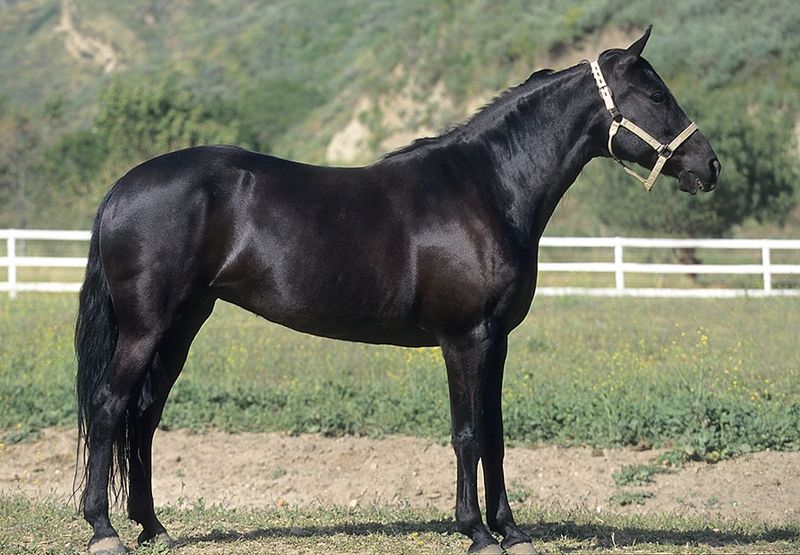
Missouri Fox Trotters bring their signature smooth ride to California’s challenging mountain trails. Their unique broken diagonal gait – the “fox trot” – keeps one foot on the ground at all times, creating a ride so smooth you can hold a cup of coffee without spilling a drop!
On a backcountry adventure through the Sierra foothills, my Fox Trotter gelding navigated rocky terrain with remarkable sure-footedness. His rhythmic head nod synced perfectly with his diagonal gait, creating an almost hypnotic effect as we covered mile after mile.
California trail riders treasure these horses for their stamina and comfortable ride. While less flashy than some breeds, Fox Trotters win hearts with their practical abilities and willing attitudes. Their medium build and efficient movement make them ideal partners for exploring California’s diverse landscapes from mountains to beaches.
12. Hardy Icelandic Horse
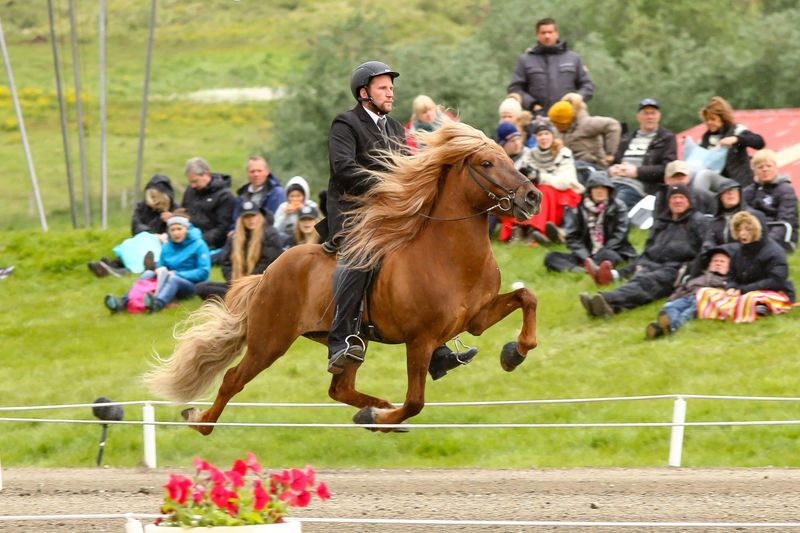
Icelandic horses may be pony-sized, but these mighty mites pack serious personality into their compact frames! Watching them show off their unique tölt gait – a four-beat lateral movement that’s incredibly smooth – at a specialty farm in Monterey County left me completely charmed.
Despite their Viking heritage from a much colder climate, these horses adapt beautifully to California living. Their thick winter coats shed out to sleek summer coats perfect for our sunshine state.
What makes these horses truly special is their five natural gaits – two more than most breeds! Beyond walk, trot, and canter, they perform the tölt and the flying pace. California enthusiasts value their incredible strength-to-size ratio – these horses easily carry adult riders despite standing just 13-14 hands high, proving that good things come in small packages!
13. Golden Haflinger
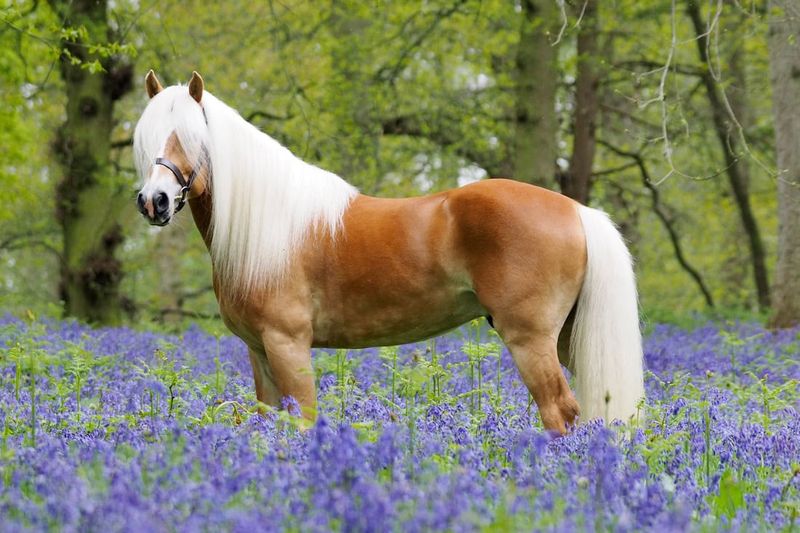
Haflingers bring sunshine to California ranches with their golden coats and flaxen manes that seem to capture our famous golden state light. These Austrian imports stand out in any pasture with their distinctive chestnut bodies and cream-colored manes and tails.
At a driving competition in the Napa Valley, I watched a team of matched Haflingers pull a carriage with impressive power and grace. Despite their modest size (typically 13-15 hands), these horses possess surprising strength developed through centuries of mountain work in the Alps.
California families particularly appreciate their kid-friendly size and generally level-headed temperaments. Originally bred as all-purpose mountain horses, they excel at everything from trail riding to dressage. Their natural athleticism combined with willing attitudes makes them versatile partners, while their distinctive golden appearance ensures they never go unnoticed on California’s show circuits.
14. Colorful American Paint Horse
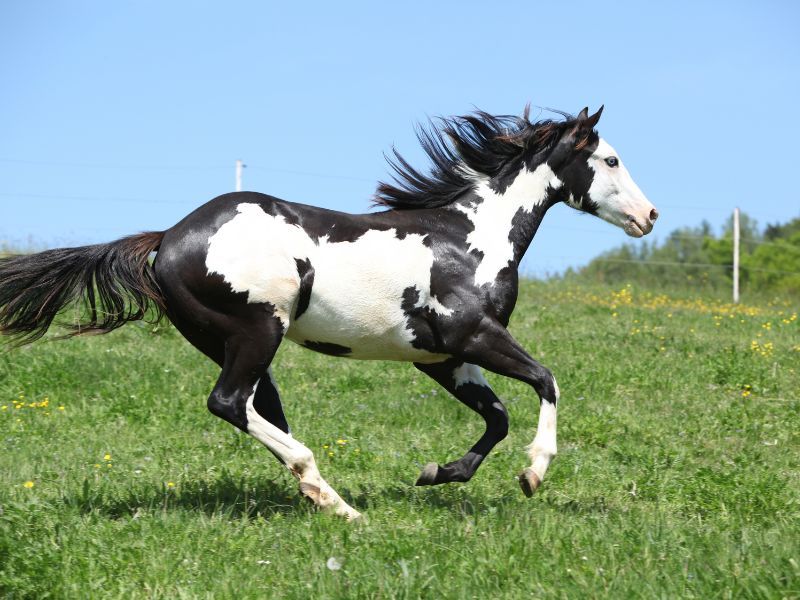
American Paint Horses splatter California landscapes with their eye-catching coat patterns, like living canvas art grazing in the fields. No two Paints have identical markings – each sports a unique combination of white with patches of black, bay, chestnut, or other colors.
Riding alongside a flashy tobiano Paint on a beach near Santa Barbara created perfect Instagram moments without filters needed! Their striking appearance comes with substance too – Paint Horses share bloodlines with Quarter Horses and Thoroughbreds, inheriting their athletic abilities.
California ranch owners value these horses for combining beauty with brains and versatility. Their willing temperaments make them excellent family horses, while their athletic abilities let them excel in everything from barrel racing to ranch work. The American Paint Horse Association maintains strict bloodline requirements – these aren’t just colorful horses, but a distinct breed with defined standards.
15. Swift Thoroughbred
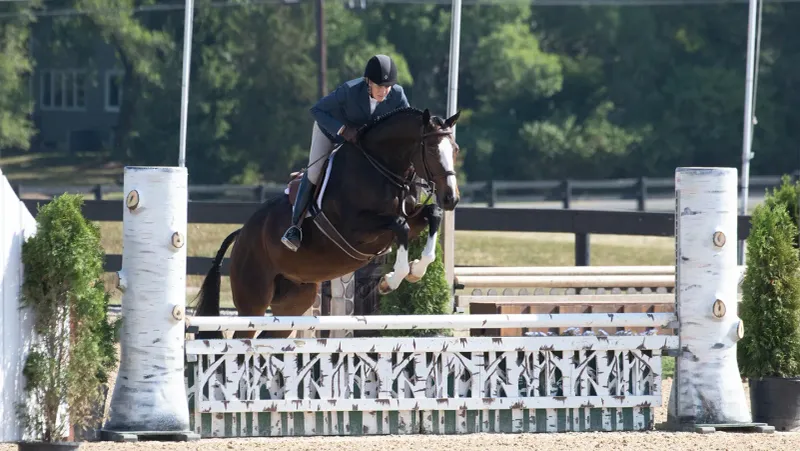
Thoroughbreds bring racetrack elegance to California’s ranch lands with their sleek lines and incredible athleticism. Standing near a Thoroughbred feels like being in the presence of a natural athlete – all muscle, grace, and barely contained energy.
My heart raced watching retired racehorse Midnight Express demonstrate his second career as a jumper at a ranch near Del Mar. His explosive speed translated perfectly to clearing obstacles with room to spare, those long legs tucking neatly beneath him mid-flight.
California’s temperate climate provides ideal conditions for these sensitive athletes. While best known for racing, Thoroughbreds excel in many disciplines after track retirement. Their intelligence and sensitivity make them responsive partners for experienced riders, while their natural forward movement creates picture-perfect form over fences or in dressage arenas throughout the state.
16. Flashy Pony Of The Americas
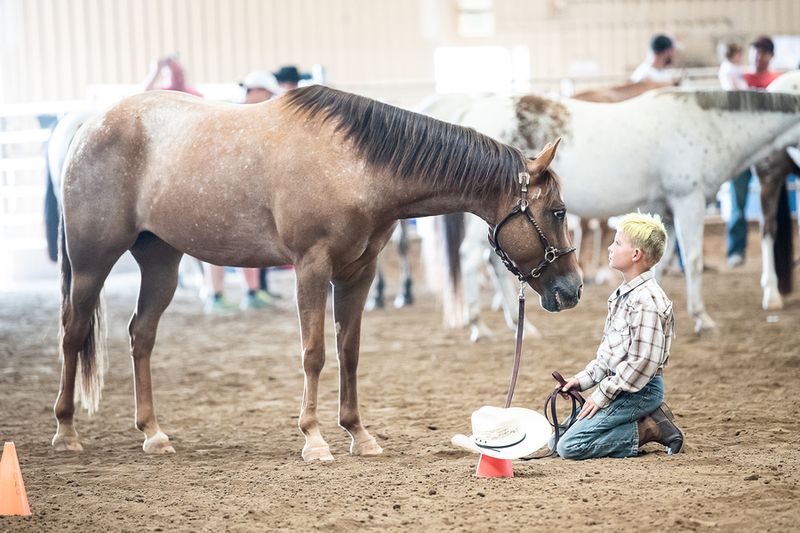
Ponies of the Americas (POAs) pack horse-sized personality into kid-friendly packages! These spotted beauties combine the best traits of Appaloosas with pony size, creating the perfect partners for young riders across California.
At a youth rodeo in Fresno, I watched in amazement as a 12-year-old girl and her spotted POA gelding outmaneuvered competitors on much larger horses. These ponies stand between 11.2 and 14 hands high – the perfect size for children while still being substantial enough to occasionally carry small adults.
California’s 4-H and Pony Club members particularly treasure these versatile mounts. Their Appaloosa heritage gives them distinctive spotted coats that capture attention in any show ring. Beyond their eye-catching appearance, POAs bring willing temperaments and athletic abilities that help young riders build confidence while learning horsemanship skills across multiple disciplines.
17. Rare Colorado Ranger
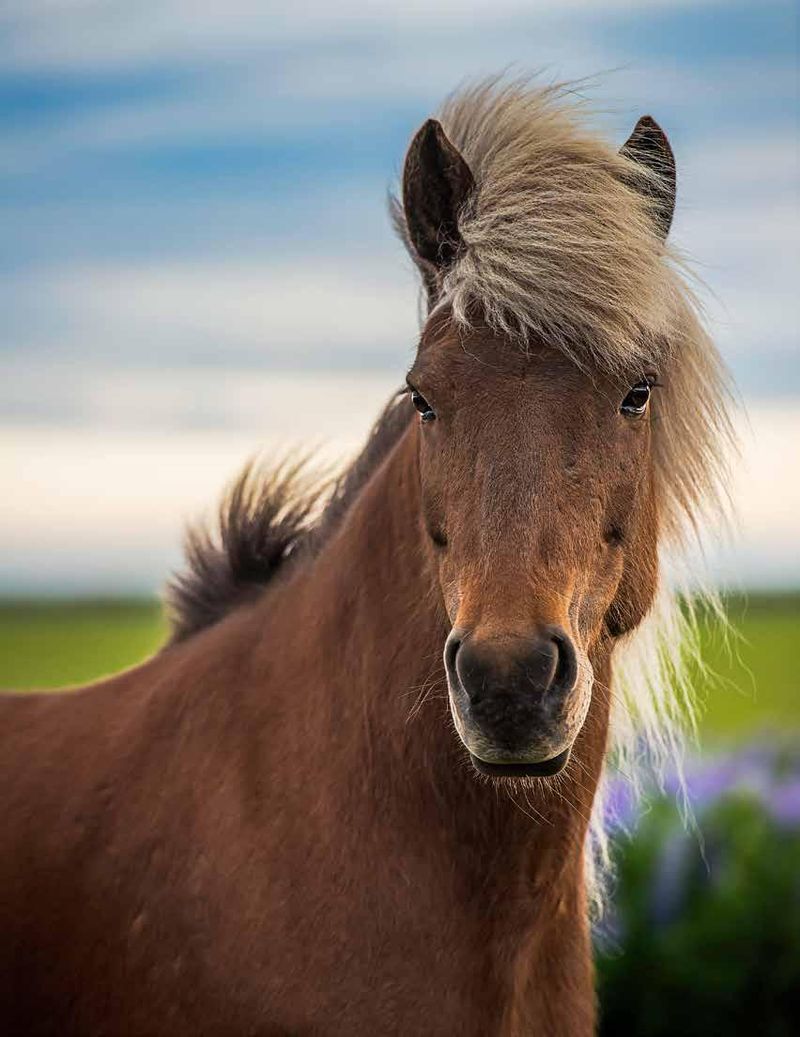
Colorado Rangers bring rare elegance to select California breeding programs with their spotted coats and refined structure. Often mistaken for Appaloosas, these horses actually trace back to two foundation stallions – Patches and Max, both descendants of the famous Barb stallion Grand Bashaw.
On a heritage breed conservation ranch in Sonoma County, I photographed a stunning leopard-spotted Colorado Ranger stallion whose presence commanded attention. The breed’s characteristic spotted coat combines with a more refined Arabian-influenced head than their Appaloosa cousins.
California conservationists work to preserve this rare breed that numbers fewer than 800 worldwide. Their willing temperaments and sure-footedness make them excellent trail horses for exploring California’s varied terrain. The breed’s versatility shines in everything from Western pleasure to jumping, while their striking appearance ensures they never blend into the background.
18. Historic Nez Perce Horse
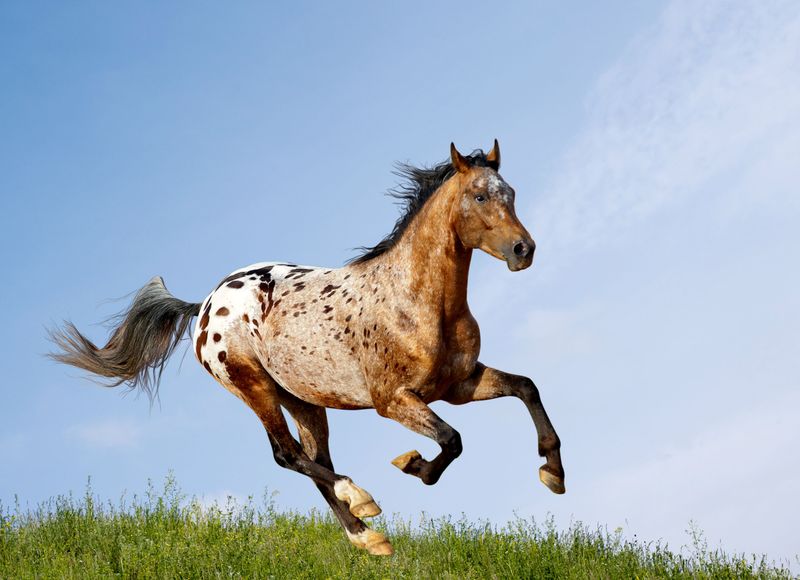
Nez Perce Horses represent living history galloping across California conservation ranches. This recently developed breed combines the colorful Appaloosa patterns beloved by the Nez Perce tribe with the smooth gaits of Akhal-Teke bloodlines.
Standing beside a foundation Nez Perce stallion at a cultural heritage event near Sacramento felt like touching living history. The breeding program began in 1995 when the Nez Perce tribe partnered with a conservation organization to create horses resembling those their ancestors rode – but with added gaited ability.
California’s cultural heritage enthusiasts treasure these rare horses. Their distinctive Appaloosa coloring comes with an unexpected bonus – many exhibit a smooth running walk gait that makes them comfortable mounts for covering long distances. The breed combines beauty, historical significance, and practical riding qualities in one stunning package.
19. Smooth Racking Horse
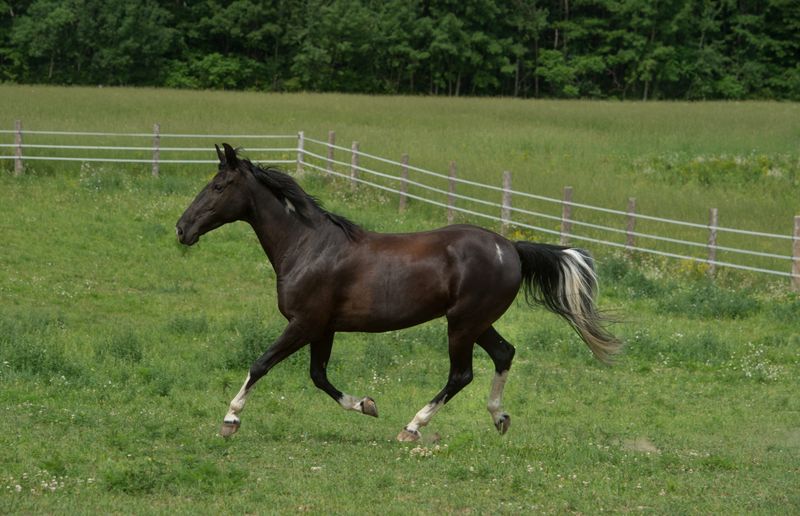
Racking Horses float across California ranches with their signature single-foot gait that seems to defy gravity. The first time I experienced this supernatural smoothness at a specialty farm in Riverside County, I understood why gaited horse enthusiasts become such passionate converts!
The rack is a four-beat gait where each hoof hits the ground separately, creating minimal motion for the rider – so smooth you can carry a full glass of water without spilling a drop. Despite this specialized ability, these horses maintain versatility for various riding disciplines.
California’s trail riding community particularly values these comfortable mounts for covering long distances without rider fatigue. Their medium build (typically 15-16 hands) makes them substantial enough for adults while remaining manageable. Beyond their practical gait, these horses bring willing temperaments and elegant conformation that turns heads whether on the trail or in the show ring.
20. Flashy Spotted Saddle Horse
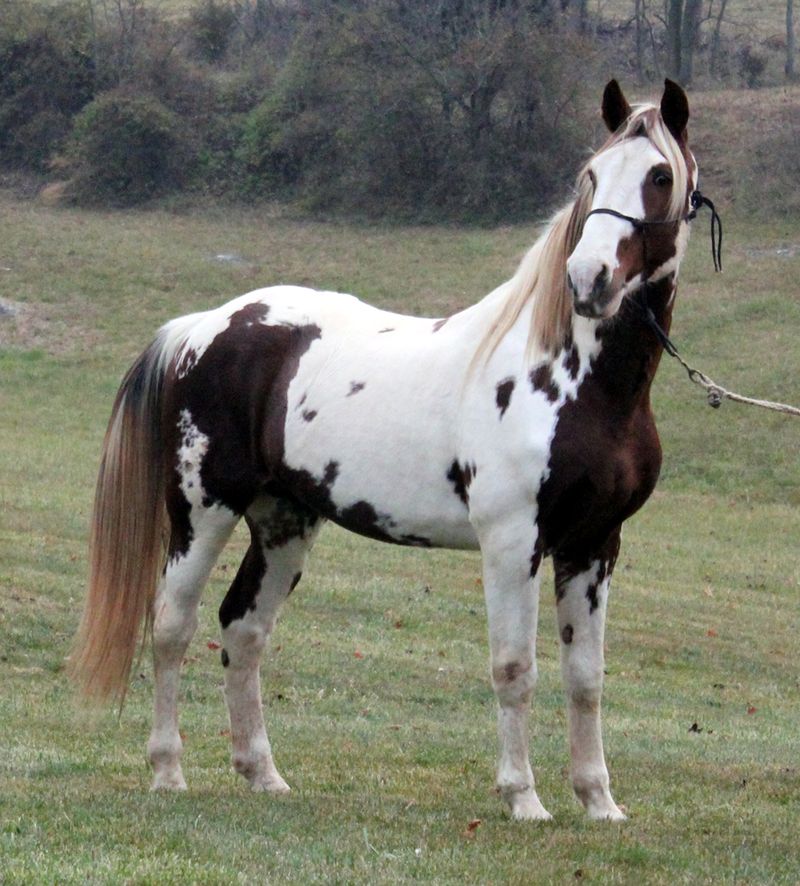
Spotted Saddle Horses bring walking horse smoothness wrapped in eye-catching packages to California’s gaited horse community. True to their name, every registered horse must have a spotted coat pattern – creating living art that moves with incredible smoothness.
At a gaited horse exhibition in San Diego County, I watched spellbound as a pinto-patterned Spotted Saddle Horse performed its natural running walk. The horse’s distinctive black and white patches created a striking vision as it moved with that signature head nod and smooth four-beat gait.
California riders with back problems particularly appreciate these horses for their shock-absorbing gaits. Developed by crossing Tennessee Walking Horses with pinto-colored breeds, these horses combine the best of both worlds – specialized smooth gaits with flashy coloring. Their generally willing temperaments make them suitable for riders of various experience levels seeking comfortable mounts.
